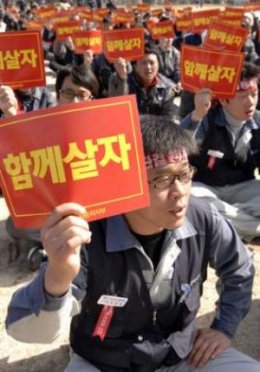Korean Sanggyong Strike Up Against the Wall
 The Ssangyong Motors strike in Pyeongtaek, South Korea (near Seoul), is now in its eighth week, and the situation of the strikers is increasingly dire.
The Ssangyong Motors strike in Pyeongtaek, South Korea (near Seoul), is now in its eighth week, and the situation of the strikers is increasingly dire.
(The following article reports “just the facts”, based on communications from workers and other activists involved in the struggle.)
The Ssangyong Motors strike in Pyeongtaek, South Korea (near Seoul), is now in its eighth week, and the situation of the strikers is increasingly dire.
To briefly reiterate the overall situation (following on my earlier report of June 19):
Ssangyong Motors is 51% owned by China’s Shanghai Automotive Industry Corporation. In February the company filed for bankruptcy, proposing a restructuring and offering the Pyeongtaek plant as collateral for further loans to re-emerge from bankruptcy. The court approved the bankruptcy plan, pending adequate layoffs to make the company profitable again.
Following job actions through the spring in anticipation of the layoffs, the current strike began on May 27 when the company announced layoffs and forced retirement of 1700 out of 7000 workers, with immediate additional firings of 300 casuals. The workers slated for layoff immediately occupied the plant, demanding no layoffs, no casualization and no outsourcing. The KMWU (Korean Metal Workers Union) supported the occupation but tried to channel negations strictly around the question of layoffs.
As of mid-June, about 1000 workers were continuing the occupation, with wives and families providing food. The government and the company bided their time, in part because of a broader political crisis of the hard-right Lee government which militated against any immediate massive police and thug attack, But two weeks later, they felt confident to go on the offensive. The workers, for their part, had armed themselves with iron crowbars and Molotov cocktails.
On June 26th-27th a serious government and employer attack began , as hired thugs, scabs recruited from the workers not slated for firing, and riot police tried to enter the factory. They secured the main building after violent fighting in which many people were injured. The occupying workers retreated to the paint sector, which was part of a defensive plan based on the belief that police would not fire tear gas canisters into the highly flammable area. (In January, five people in Seoul died in another fire set off during a confrontation with police, sparking weeks of outrage.).
The following day, the company issued a statement to the effect that there had been enough violence, but in reality in recognition of the tenacious worker resistance, and police and thugs were withdrawn. The company urged the government to involve itself directly in negations. All water in the plant was nonetheless cut off at the end of June.
Following a court order, the forces of repression struck again on July 11 as the riot police moved to seize the factory area with the exception of the paint sector, and encircled the entire factory.
Ever since the attack of the 26th-27th attack aimed at isolating Ssangyong’s struggle and breaking the strike, solidarity actions outside the plant were attempting to build broader support. These included a street campaign, mainly from family organizations in the center of Seoul and Pyeongtaek areas, a 4-hour general strike by the KMWU during which metal workers from nearby plants rallied in front of Ssangyong factory gate; on July 4th , and July 11 the KCTU (Korean Confederation of Trade Unions) held nationwide labor rallies in support of the Ssangyong’s struggle. These actions were however poorly attended and the leadership of the KMWU has hesitated in declaring an all-out strike in response to the attacks on the plant. Activists think the KMWU and KCTU leaderships are more preoccupied with upcoming union elections. (927 activists also held a one –day hunger strike in the center of Seoul on July 11.) (From my experience in Korea over the past four years, these are largely ritual actions which rarely influence the outcome of a struggle.)
Finally, on July 16, 3,000 KMWU members gathered to support the Ssangyong strike in front of the Pyeongtaek City Hall. When they tried to move to the factory after the rally, they were blocked by police and 82 workers were arrested on the spot.
All in all, chances for a serious generalization of the struggle to other factories look remote. Activists on the scene feel that even if the KMWU called a general strike, only a few districts would follow it. The Hyundai auto workers are in the midst of wage negotiations themselves. Nearby supplier plants have already gone through structural adjustment and are not likely to mobilize.
Loren Goldner






